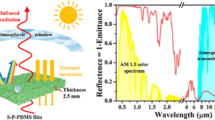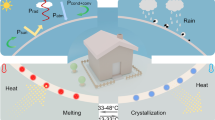Abstract
Passive daytime radiative cooling (PDRC) is an emerging nonpolluting, nonenergy-consuming cooling technology that relies on high reflectivity in the solar band and high emissivity in the infrared band. As an outdoor-oriented cooling material, its mechanical durability and optical stability are of great significance for long-term application. Herein, we fabricated a superhydrophobic polydimethylsiloxane-based film filled with regular hollow glass beads simply by blending, coating, and drying without using any solvents, followed by surface sanding. The hollow glass beads made the film possess regular hollow structures enabling the surface to maintain the superhydrophobic and optical properties even after severe abrasion. The as-fabricated film boasts a solar reflectance of 96.0%, a mid-infrared emissivity of 97.8% and a water contact angle of 163.9°, and achieves a cooling effect of 11.7 °C under direct sunlight. Additionally, these films can be applied as coatings to various substrates and offer appealing features such as self-cleaning, chemical stability, and weather resistance, making them highly suitable for outdoor applications. The entire preparation process is nontoxic and does not involve organic solvents, thereby expanding the range of preparation methods and application fields for PDRC materials.
Graphical abstract










Similar content being viewed by others
Data availability
The authors own all of the material/data.
References
Wang Y, Yan PC, Ji F et al (2021) Unnatural trend of global land long-term surface air temperature change. Int J Climatol 41:2330–2341. https://doi.org/10.1002/joc.6961
Li DH, Zhuang BR, Chen YC et al (2022) Incorporation technology of bio-based phase change materials for building envelope: a review. Energy Build 260:111920. https://doi.org/10.1016/j.enbuild.2022.111920
Alsuhaibani AM, Refat MS, Qaisrani SA et al (2023) Green buildings model: Impact of rigid polyurethane foam on indoor environment and sustainable development in energy sector. Heliyon 9:e14451. https://doi.org/10.1016/j.heliyon.2023.e14451
Hsu PC, Song AY, Catrysse PB et al (2016) Radiative human body cooling by nanoporous polyethylene textile. Science 353:1019–1023. https://doi.org/10.1126/science.aaf5471
Grocholski B (2020) Cooling in a warming world. Science 370:776–777. https://doi.org/10.1126/science.abf1931
Liu DW, Xia ZL, Shi KL et al (2019) A thermally stable cooler for efficient passive radiative cooling throughout the day. Opt Mater 92:330–334. https://doi.org/10.1016/j.optmat.2019.04.061
Tang HJ, Zhou ZH, Jiao SF et al (2022) Radiative cooling of solar cells with scalable and high-performance nanoporous anodic aluminum oxide. Sol Energy Mater Sol Cells 235:111498. https://doi.org/10.1016/j.solmat.2021.111498
Chen Z, Zhu LX, Raman A et al (2016) Radiative cooling to deep sub-freezing temperatures through a 24-h day–night cycle. Nat Commun 7:13729. https://doi.org/10.1038/ncomms13729
Xu CF, Ao XZ, Zhao B et al (2021) A novel selective emissivity spectrum for radiative sky cooling. Sol Energy Mater Sol Cells 232:111380. https://doi.org/10.1016/j.solmat.2021.111380
Bhatia B, Leroy A, Shen YC et al (2018) Passive directional sub-ambient daytime radiative cooling. Nat Commun 9:5001. https://doi.org/10.1038/s41467-018-07293-9
Li D, Liu X, Li W et al (2021) Scalable and hierarchically designed polymer film as a selective thermal emitter for high-performance all-day radiative cooling. Nat Nanotechnol 16:153–158. https://doi.org/10.1038/s41565-020-00800-4
Dong Y, Han H, Wang FQ et al (2022) A low-cost sustainable coating: Improving passive daytime radiative cooling performance using the spectral band complementarity method. Renew Energy 192:606–616. https://doi.org/10.1016/j.renene.2022.04.093
Huang MC, Yang MP, Guo XJ et al (2023) Scalable multifunctional radiative cooling materials. Prog Mater Sci 137:101144. https://doi.org/10.1016/j.pmatsci.2023.101144
Cao D, Li XM, Gu Y (2022) Highly optically selective polyethylene porous films as versatile optical shields for daytime radiative cooling applications. Sol Energy Mater Sol Cells 240:111727. https://doi.org/10.1016/j.solmat.2022.111727
Wong RYM, Tso CY, Chao CYH (2021) Thermo-radiative energy conversion efficiency of a passive radiative fluid cooling system. Renew Energy 180:700–711. https://doi.org/10.1016/j.renene.2021.08.109
Zhao JT, Nan F, Zhou L et al (2023) Free-standing, colored, polymer film with composite opal photonic crystal structure for efficient passive daytime radiative cooling. Sol Energy Mater Sol Cells 251:112136. https://doi.org/10.1016/j.solmat.2022.112136
Wu D, Liu C, Xu ZH et al (2018) The design of ultra-broadband selective near-perfect absorber based on photonic structures to achieve near-ideal daytime radiative cooling. Mater Des 139:104–111. https://doi.org/10.1016/j.matdes.2017.10.077
Kort-Kamp WJM, Kramadhati S, Azad AK et al (2018) Passive radiative “thermostat” enabled by phase-change photonic nanostructures. ACS Photonics 5:4554–4560. https://doi.org/10.1021/acsphotonics.8b01026
Bijarniya JP, Sarkar J, Maiti P (2020) Environmental effect on the performance of passive daytime photonic radiative cooling and building energy-saving potential. J Clean Prod 274:123119. https://doi.org/10.1016/j.jclepro.2020.123119
Fan SH, Raman A (2018) Metamaterials for radiative sky cooling. Natl Sci Rev 5:132–133. https://doi.org/10.1093/nsr/nwy012
Zhai Y, Ma YG, David SN et al (2017) Scalable-manufactured randomized glass-polymer hybrid metamaterial for daytime radiative cooling. Science 355:1062–1066. https://doi.org/10.1126/science.aai7899
Kong AR, Cai BY, Shi P et al (2019) Ultra-broadband all-dielectric metamaterial thermal emitter for passive radiative cooling. Opt Express 27:30102–30115. https://doi.org/10.1364/OE.27.030102
Huang YJ, Pu MB, Zhao ZY et al (2018) Broadband metamaterial as an “invisible” radiative cooling coat. Optics Commun 407:204–207. https://doi.org/10.1016/j.optcom.2017.09.036
Woo HY, Choi Y, Chung H et al (2023) Colloidal inorganic nano- and microparticles for passive daytime radiative cooling. Nano Convergence 10:17. https://doi.org/10.1186/s40580-023-00365-7
Huang J, Fan DS, Li Q (2022) Structural rod-like particles for highly efficient radiative cooling. Mater Today Energy 25:100955. https://doi.org/10.1016/j.mtener.2022.100955
Huang J, Li MZ, Fan DS (2021) Core-shell particles for devising high-performance full-day radiative cooling paint. Appl Mater Today 25:101209. https://doi.org/10.1016/j.apmt.2021.101209
Du TT, Niu J, Wang LY et al (2022) Daytime radiative cooling coating based on the Y2O3/TiO2 microparticle-embedded PDMS polymer on energy-saving buildings. ACS Appl Mater Interfaces 14:51351–51360. https://doi.org/10.1021/acsami.2c15854
Wang L, Zheng ZH, Gou YC et al (2021) Fabry-Perot resonance assisted dual-layer coating with enhanced wavelength-selective refection and emission for daytime radiative cooling. Optics Commun 483:126673. https://doi.org/10.1016/j.optcom.2020.126673
Li N, Wei LM, You MZ et al (2023) Hierarchically structural TiO2-PVDF fiber film with particle-enhanced spectral performance for radiative sky cooling. Sol Energy 259:41–48. https://doi.org/10.1016/j.solener.2023.05.011
Yang ZB, Jiang TK, Zhang J (2021) Passive daytime radiative cooling inorganic-polymeric composite artificial lawn for the alternative to the natural lawn. Sol Energy Mater Sol Cells 219:110783. https://doi.org/10.1016/j.solmat.2020.110783
Zhou K, Li W, Patel BB et al (2021) Three-dimensional printable nanoporous polymer matrix composites for daytime radiative cooling. Nano Lett 21:1493–1499. https://doi.org/10.1021/acs.nanolett.0c04810
Bijarniya JP, Sarkar J, Tiwari S et al (2023) Development and degradation analysis of novel three-layered sustainable composite coating for daytime radiative cooling. Sol Energy Mater Sol Cells 257:112386. https://doi.org/10.1016/j.solmat.2023.112386
Tian Q, Tu XT, Yang L et al (2022) Super-large-scale hierarchically porous films based on self-assembled eye-like air pores for high-performance daytime radiative cooling. Small 18:2205091. https://doi.org/10.1002/smll.202205091
Hu RJ, Wang N, Hou LL et al (2022) Bilayer nanoporous polyethylene membrane with anisotropic wettability for rapid water transportation/evaporation and radiative cooling. ACS Appl Mater Interfaces 14:9833–9843. https://doi.org/10.1021/acsami.1c22974
Hu LC, Xue CH, Liu BY et al (2022) Scalable superhydrophobic flexible nanofiber film for passive daytime radiative cooling. ACS Appl Polym Mater 4:3343–3351. https://doi.org/10.1021/acsapm.1c01907
Huang MC, Xue CH, Huang JY et al (2022) A hierarchically structured self-cleaning energy-free polymer film for daytime radiative cooling. Chem Eng J 442:136239. https://doi.org/10.1016/j.cej.2022.136239
Liu BY, Xue CH, Zhong HM et al (2021) Multi-bioinspired self-cleaning energy-free cooling coatings. J Mater Chem A 9:24276–24282. https://doi.org/10.1039/D1TA07953K
Ni JH, Zhang YX, Song ZF et al (2023) Salt-template-assisted melt-processed porous poly (vinylidene fluoride) nanocomposites for highly efficient all-day passive radiative cooling. Compos A Appl Sci Manuf 164:107311. https://doi.org/10.1016/j.compositesa.2022.107311
Liu JW, Tang HJ, Jiang CX et al (2022) Micro-nano porous structure for efficient daytime radiative sky cooling. Adv Func Mater 32:2206962. https://doi.org/10.1002/adfm.202206962
Li MZ, Yan Z, Fan DS (2023) Flexible radiative cooling textiles based on composite nanoporous fibers for personal thermal management. ACS Appl Mater Interfaces 15:17848–17857. https://doi.org/10.1021/acsami.3c00252
Tang X (2023) Multifunctional droplet-surface interaction effected by bulk properties. Droplet 2:e38. https://doi.org/10.1002/dro2.38
Xu FF, Wang FJ, Lei S et al (2023) Superhydrophobic poly-4-methyl-1-pentene/polyvinylidene fluoride coating with excellent passive daytime radiation cooling performance. Appl Phys A 129:266. https://doi.org/10.1007/s00339-023-06560-x
Ye X, Li YY, Zhang Y et al (2022) Superhydrophobic polyurethane membrane with a biomimetically hierarchical structure for self-cleaning. ACS Appl Mater Interfaces 14:49274–49283. https://doi.org/10.1021/acsami.2c13208
Wang H-D, Xue C-H, Ma C-Q et al (2024) Durable and scalable superhydrophobic colored composite coating for subambient daytime radiative cooling. ACS Sustain Chem Eng 12:1681–1693. https://doi.org/10.1021/acssuschemeng.3c07329
Wang T, Zhang Y, Chen M et al (2022) Scalable and waterborne titanium-dioxide-free thermochromic coatings for self-adaptive passive radiative cooling and heating. Cell Reports Phys Sci 3:100782. https://doi.org/10.1016/j.xcrp.2022.100782
Yang Y, Jiang M, Ma Z et al (2023) The coating with ZrO2-coated hollow glass microspheres: Low solar absorption and high microwave transmittance. Mater Des 232:112136. https://doi.org/10.1016/j.matdes.2023.112136
Wu Q, Cui Y, Xia G et al (2023) Passive daytime radiative cooling coatings with renewable self-cleaning functions. Chinese Chem Lett 35(2):108687. https://doi.org/10.1016/j.cclet.2023.108687
Zhang H, Ly KCS, Liu X et al (2020) Biologically inspired flexible photonic films for efficient passive radiative cooling. Proc Natl Acad Sci 117:14657–14666. https://doi.org/10.1073/pnas.2001802117
Acknowledgements
This work was supported by the National Natural Science Foundation of China (52103263, 52271249), Key Project of International Science & Technology Cooperation of Shaanxi Province (2023-GHZD-09), Key project of Science Foundation of Education Department of Shaanxi Province (22JY011), Key Project of Scientific Research and Development of Shaanxi Province (2023GXLH-070), Qinchuangyuan “Scientist + Engineer” Team of Shaanxi Province (2023KXJ-069), Key Research and Development Program of Shaanxi Province (2020ZDLGY13-11), Key Research and Development Program of Shaanxi (2023-YBGY-488), and Sci-tech Innovation Team of Shaanxi Province (2024RS-CXTD-46).
Funding
The Funding was provided by National Natural Science Foundation of China, 52103263, Xiao-Jing Guo, 52271249, Jun Cheng, Key Project of International Science & Technology Cooperation of Shaanxi Province, 2023-GHZD-09, Chao-Hua Xue, Key project of Science Foundation of Education Department of Shaanxi Province, 22JY011, Xiao-Jing Guo, Key Project of Scientific Research and Development of Shaanxi Province, 2023GXLH-070, Chao-Hua Xue, Shaanxi Key Laboratory of Land Reclamation Engineering, 2023KXJ-069, Chao-Hua Xue, Key Research and Development Program of Shaanxi Province, 2020ZDLGY13-11, Chao-Hua Xue, Key Research and Development Program of Shaanxi, 2023-YBGY-488, Jun Cheng, Sci-tech Innovation Team of Shaanxi Provience, 2024RS-CXTD-46, Chao-Hua Xue
Author information
Authors and Affiliations
Contributions
SQL involved in investigation, writing-original draft, visualization, methodology. CHX involved in conceptualization, funding acquisition, project administration, supervision, writing–review and editing. XJG involved in funding acquisition, project administration, supervision, writing-review and editing. HDW involved in data curation, methodology. MCH involved in methodology, validation. CQM involved in methodology, validation. WMZ involved in data curation, software. RRG involved in methodology, validation. YGW involved in data curation, methodology. JC involved in funding acquisition. JL involved in funding acquisition. HWW involved in funding acquisition, resources.
Corresponding authors
Ethics declarations
Conflict of interest
The authors declare that they have no known competing financial interests or personal relationships that could have appeared to influence the work reported in this paper.
Supplementary Information
Not applicable.
Ethical approval.
Not applicable.
Additional information
Handling Editor: Maude Jimenez.
Publisher's Note
Springer Nature remains neutral with regard to jurisdictional claims in published maps and institutional affiliations.
Rights and permissions
Springer Nature or its licensor (e.g. a society or other partner) holds exclusive rights to this article under a publishing agreement with the author(s) or other rightsholder(s); author self-archiving of the accepted manuscript version of this article is solely governed by the terms of such publishing agreement and applicable law.
About this article
Cite this article
Lv, SQ., Xue, CH., Guo, XJ. et al. Solvent-free fabrication of mechanically durable superhydrophobic film with regular hollow structures for passive cooling. J Mater Sci 59, 4252–4266 (2024). https://doi.org/10.1007/s10853-024-09500-z
Received:
Accepted:
Published:
Issue Date:
DOI: https://doi.org/10.1007/s10853-024-09500-z




